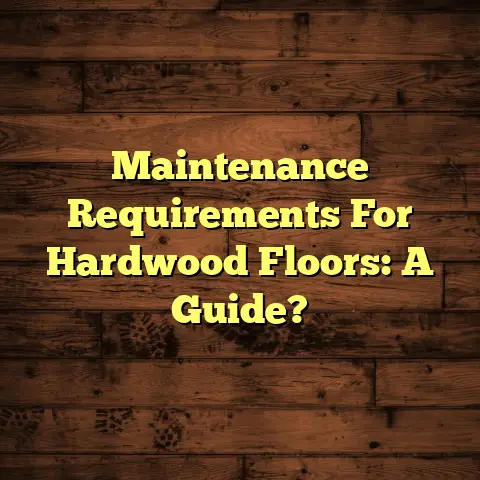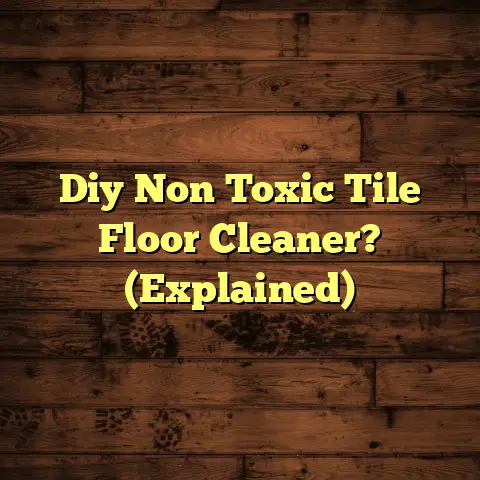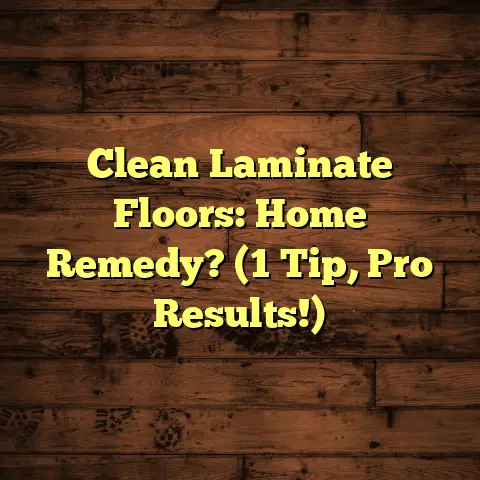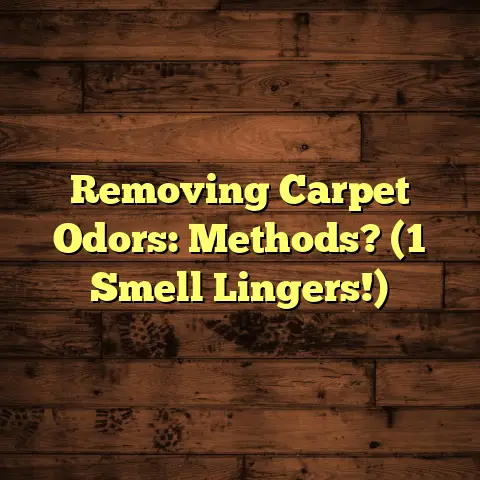Hardwood Floor Buffing: The Ultimate Guide (DIY or Pro?)
Hardwood floors are like the little black dress of home design – timeless, elegant, and they boost your home’s value. But just like that dress, they need some TLC to stay stunning. That’s where buffing comes in.
The big question is: can you handle buffing yourself, or should you call in a pro? Let’s dive into the nitty-gritty, and I’ll help you figure out what’s best for your floors.
Section 1: Understanding Hardwood Floors
1. Types of Hardwood Floors
So, what are we even working with here? Not all hardwood is created equal. Let’s break down the main types:
-
Solid Hardwood: This is the real deal – planks made from a single piece of wood. Think oak, maple, walnut, and cherry. It’s beautiful, durable, and can be refinished multiple times, making it a long-term investment. Solid hardwood is generally more expensive than engineered.
-
Engineered Hardwood: This is constructed with multiple layers of wood, with a hardwood veneer on top. It’s more stable than solid hardwood, meaning it’s less likely to warp or expand with changes in humidity. It’s a great choice for basements or kitchens.
-
Laminate Flooring: While technically not hardwood, laminate often mimics the look of wood. It’s made of a composite material with a photographic layer on top. Laminate is budget-friendly and easy to install, but it can’t be refinished.
The type of flooring you have will impact the way you maintain it. For example, I’d be way more aggressive with solid hardwood than I would with laminate.
2. Common Issues with Hardwood Floors
Life happens, right? And sometimes, life leaves its mark on your hardwood floors. Here are some common issues I see:
-
Scratches: Pets, furniture, kids… they all contribute to scratches. Even tiny scratches can dull the finish and make the floor look worn.
-
Dullness: Over time, the finish on your hardwood can lose its shine. This is often due to everyday wear and tear, as well as the buildup of dirt and grime.
-
Water Damage: Spills, leaks, and high humidity can cause water damage, leading to warping, staining, and even mold.
-
Gaps: As wood expands and contracts with temperature and humidity, gaps can form between the planks.
These issues are where buffing can really shine (pun intended!).
3. The Role of Buffing in Maintenance
Alright, let’s get down to business. What is buffing, anyway?
Buffing is like a gentle exfoliation for your hardwood floors. It uses a machine with a rotating pad to lightly polish the surface, removing minor scratches, scuffs, and embedded dirt. Think of it as a deep clean and shine booster.
Here’s why buffing is your floor’s best friend:
-
Restores Shine: Buffing removes the dull, hazy layer on your floors, revealing the beautiful shine underneath.
-
Removes Surface Scratches: Light scratches and scuffs can be buffed away, making the floor look smoother and newer.
-
Prepares for Refinishing: If your floors are severely damaged, buffing can help prepare the surface for a fresh coat of finish. It creates a smooth, even surface for the new finish to adhere to.
Buffing is also less invasive than sanding and refinishing. Sanding removes a layer of the wood itself, while buffing only affects the finish.
Section 2: DIY Buffing: An In-Depth Look
Feeling brave? Want to tackle buffing yourself? Here’s how to do it right.
1. Tools and Materials Needed
Before you start, gather your supplies. Here’s what you’ll need:
-
Floor Buffer: You can rent these from most hardware stores or tool rental centers. Look for a buffer with variable speed settings. Expect to pay around $50-$100 per day for rental.
-
Buffing Pads: You’ll need different pads for different purposes. A coarse pad is good for removing heavier scratches, while a fine pad is for polishing. I personally like 3M pads.
-
Floor Cleaner: Use a pH-neutral cleaner specifically designed for hardwood floors. Avoid harsh chemicals or abrasive cleaners.
-
Safety Gear: Eye protection, a dust mask, and earplugs are essential. Buffing can create a lot of dust and noise.
-
Vacuum and Mop: For cleaning up before and after buffing.
-
Painter’s Tape: To protect baseboards and trim.
You can find most of these items at your local home improvement store or online.
2. Step-by-Step Guide to DIY Buffing
Okay, let’s get buffing!
Step 1: Prepare the Area
- Clear the Room: Remove all furniture, rugs, and other obstacles from the room.
- Clean the Floor: Thoroughly vacuum the floor to remove any dirt, dust, or debris. Then, mop with your hardwood floor cleaner. Make sure the floor is completely dry before you start buffing.
- Protect Baseboards: Use painter’s tape to protect your baseboards and trim from the buffer.
Step 2: Choose the Right Buffer and Pad
- Start with a Coarse Pad: If your floors have a lot of scratches, start with a coarse buffing pad to remove the imperfections.
- Switch to a Fine Pad: Once you’ve removed the scratches, switch to a fine pad to polish the floor and restore its shine.
Step 3: The Buffing Technique
- Start in a Corner: Begin in a corner of the room and work your way across the floor in overlapping passes.
- Keep the Buffer Moving: Don’t let the buffer sit in one spot for too long, or you could damage the finish.
- Use Light Pressure: Let the weight of the buffer do the work. Don’t press down too hard, or you could scratch the floor.
- Buff in the Direction of the Grain: This will help to minimize the appearance of scratches.
- Overlap Your Passes: Overlap each pass by about 50% to ensure even coverage.
- Adjust the Speed: Start with a low speed and gradually increase it as needed.
- Take Breaks: Buffing can be tiring, so take breaks as needed.
Step 4: Post-Buffing Care
- Vacuum Again: Vacuum the floor to remove any dust or debris created by the buffing process.
- Mop Lightly: Lightly mop the floor with your hardwood floor cleaner to remove any remaining residue.
- Apply a Protective Finish (Optional): If you want to add an extra layer of protection, you can apply a coat of hardwood floor polish or wax.
3. Tips for Successful DIY Buffing
Here are some insider tips to help you avoid common mistakes:
- Don’t Use Too Much Pressure: Let the machine do the work. Pushing down too hard can damage the finish.
- Buff in the Right Direction: Always buff in the direction of the wood grain.
- Ensure the Floor is Completely Dry: Before and after buffing. Moisture can damage the wood.
- Test in an Inconspicuous Area: Before you start buffing the entire floor, test the buffer and pad in a closet or under a piece of furniture to make sure you’re getting the desired results.
- Change Pads Frequently: As the buffing pad becomes clogged with dirt and debris, it will become less effective. Change pads frequently to maintain optimal performance.
- Be Patient: Buffing takes time and effort. Don’t rush the process, or you could end up with uneven results.
Section 3: When to Call in the Pros
DIY is great, but sometimes, you need to call in the cavalry.
1. Identifying Complex Issues
Sometimes, buffing just isn’t enough. Here are some signs you need professional help:
- Deep Scratches: If you can feel the scratches with your fingernail, buffing probably won’t remove them.
- Significant Wear: If the finish is completely worn away in certain areas, buffing won’t restore it.
- Water Damage: Warping, staining, or mold requires professional attention.
- Uneven Finish: If the finish is peeling or flaking, buffing will only make the problem worse.
- Large Area: If you have a very large area to buff, it may be more efficient to hire a professional.
2. Benefits of Hiring Professionals
Why shell out the extra cash? Here’s what pros bring to the table:
- Expertise and Experience: Pros have seen it all and know how to handle different types of hardwood floors and finishes.
- Advanced Tools and Techniques: They have access to professional-grade buffers and pads that are more powerful and effective than what you can rent.
- Time-Saving and Convenience: Let’s face it, buffing is hard work. Hiring a pro frees up your time and energy.
- Dust Control: Pros use specialized equipment to minimize dust, which is a huge plus.
3. What to Expect from Professional Services
What happens when you hire a pro? Here’s the typical process:
- Inspection: The pro will inspect your floors to assess the damage and determine the best course of action.
- Cleaning: The floor will be thoroughly cleaned to remove any dirt, dust, or debris.
- Buffing: The pro will use a professional-grade buffer and appropriate pads to buff the floor.
- Additional Services (Optional): Depending on the condition of your floors, the pro may recommend additional services such as refinishing or recoating.
Section 4: Cost Considerations
Let’s talk money.
1. DIY vs. Professional Buffing Costs
Here’s a cost breakdown:
DIY Buffing:
- Buffer Rental: $50-$100 per day
- Buffing Pads: $20-$50
- Floor Cleaner: $10-$20
- Safety Gear: $20-$30
- Total: $100-$200+
Professional Buffing:
- Cost per Square Foot: $1-$3 (This can vary depending on your location, the size of the area, and the condition of the floors.)
- Minimum Service Fee: Some pros may have a minimum service fee, which can range from $100 to $300.
So, for a 500 square foot room, you might pay $500-$1500 for professional buffing.
2. Long-Term Value
Regular buffing, whether DIY or professional, is an investment in the long-term value of your hardwood floors. It can prevent the need for more expensive repairs or replacements down the road.
According to the National Wood Flooring Association (NWFA), well-maintained hardwood floors can last for 100 years or more.
Section 5: Maintaining Buffed Hardwood Floors
You’ve buffed, now what?
1. Post-Buffing Care
- Use a pH-Neutral Cleaner: Avoid harsh chemicals or abrasive cleaners.
- Use a Microfiber Mop: Microfiber mops are gentle on hardwood floors and won’t scratch the finish.
- Clean Up Spills Immediately: Don’t let spills sit on the floor for too long, or they could stain or damage the finish.
- Use Furniture Pads: Protect your floors from scratches by using furniture pads under all furniture legs.
- Avoid High Heels: High heels can dent and scratch hardwood floors.
2. Regular Maintenance Schedule
- Daily: Sweep or vacuum to remove dirt and debris.
- Weekly: Mop with a pH-neutral cleaner.
- Monthly: Inspect your floors for scratches, wear, and water damage.
- Yearly: Buff your floors to restore shine and remove surface scratches.
3. Signs It’s Time to Buff Again
- Dullness: If your floors are starting to look dull, it’s time to buff.
- Scratches: If you notice a lot of scratches, buffing can help to remove them.
- Footprints: If you can see footprints on your floors, it’s time to buff.
- Loss of Shine: If your floors have lost their shine, buffing can help to restore it.
Conclusion: Making the Right Choice for Your Floors
So, DIY or pro? It really depends on your budget, skill level, and the condition of your floors.
If you’re comfortable with DIY projects and your floors are in good condition, DIY buffing can be a cost-effective way to maintain their beauty.
However, if your floors are severely damaged or you’re not comfortable with DIY projects, hiring a professional is the best option.
No matter which option you choose, regular buffing is essential for maintaining the beauty and longevity of your hardwood floors.
Closing Thought:
There’s nothing quite like the feeling of walking on beautifully maintained hardwood floors. Whether you choose to do it yourself or hire a professional, taking care of your floors is an investment that will pay off for years to come.





